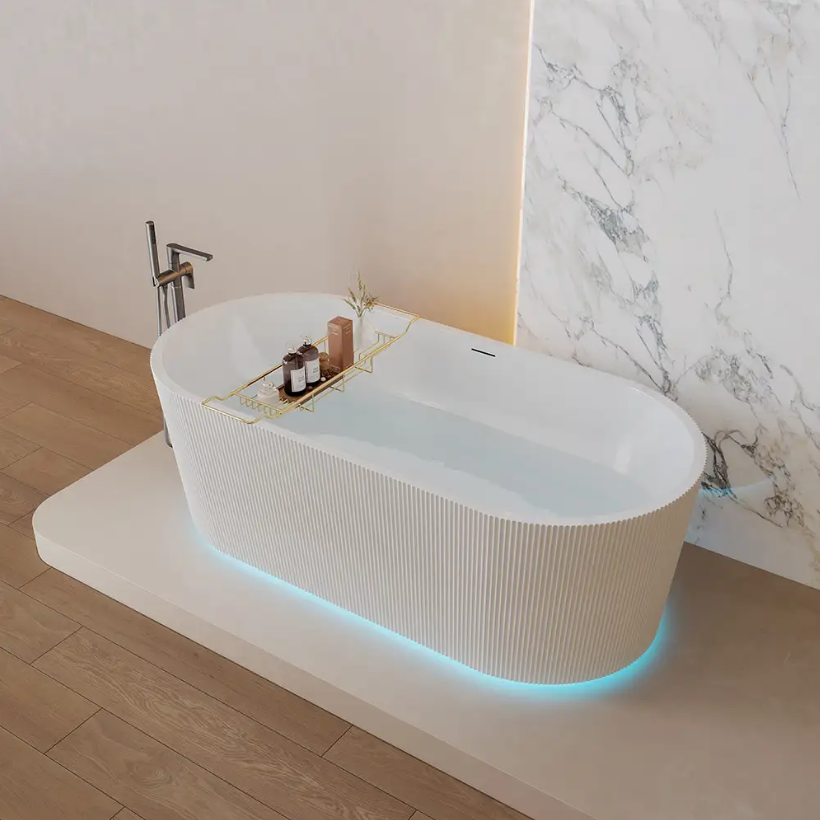อะคริลิกทั่วไป อ่างอาบน้ํา ปัญหาและสาเหตุของปัญหา
รอยขีดข่วนบนผิวและรอยแตกร้าวเล็กๆ
อ่างอาบน้ำอะคริลิกมักจะเกิดรอยขีดข่วนได้ง่ายมาก โดยส่วนใหญ่เกิดจากผู้ใช้งานใช้สารทำความสะอาดที่มีฤทธิ์กัดกร่อนหรือใช้แผ่นขัดหยาบในการทำความสะอาด รอยขีดข่วนเหล่านี้ไม่ใช่แค่ปัญหาเรื่องรูปลักษณ์อย่างเดียวเท่านั้น แต่ในระยะยาว แม้กระทั่งแรงกระแทกเล็กน้อยจากการทำขวดแชมพูหรือสิ่งของอื่นๆ ตกใส่อ่าง หรือการใช้งานเป็นประจำทุกวัน ก็อาจก่อให้เกิดรอยร้าวเล็กๆ ที่รบกวนใจและไม่มีใครอยากเห็นได้ ข่าวดีคือ มีวิธีป้องกันไม่ให้ปัญหาเหล่านี้เกิดขึ้น ให้ใช้วิธีทำความสะอาดที่อ่อนโยนแทน เช่น ใช้ผ้าที่นุ่มทำความสะอาด พร้อมกับสารทำความสะอาดที่อ่อนโยนและไม่กัดกร่อน รวมถึงควรตรวจสอบสภาพอ่างอาบน้ำอย่างรวดเร็วเป็นประจำทุกสัปดาห์ การตรวจพบปัญหาเล็กๆ น้อยๆ แต่เนิ่นๆ จะช่วยลดโอกาสที่ต้องซ่อมแซมที่มีค่าใช้จ่ายสูงในอนาคต ผู้ใช้งานส่วนใหญ่พบว่า การดูแลเอาใจใส่และหลีกเลี่ยงการใช้งานวิธีการที่รุนแรงนั้น ช่วยให้อ่างอาบน้ำอะคริลิกคงสภาพใหม่ได้นานหลายปี
คราบสกปรกฝังแน่นและการเปลี่ยนสี
อ่างอาบน้ำอะคริลิกมักมีคราบและสีซีดจางลงตามกาลเวลา ส่วนใหญ่เกิดจากคราบสบู่สะสม เชื้อรา และคราบน้ำกระด้างที่น่ารำคาญ ปัญหาเหล่านี้ก่อให้เกิดรอยด่างดำที่น่าเกลียดซึ่งบั่นทอนความสวยงามของอ่างอาบน้ำ สำหรับการกำจัดคราบฝังแน่น ผู้คนพบว่าการผสมน้ำส้มสายชูกับเบกกิ้งโซดาได้ผลดี อย่างไรก็ตาม ผู้เชี่ยวชาญด้านการทำความสะอาดส่วนใหญ่แนะนำให้ใช้น้ำยาทำความสะอาดที่อ่อนโยนกว่าสำหรับการทำความสะอาดประจำวัน การผสมน้ำยาล้างจานลงในน้ำอุ่นเพียงเล็กน้อยก็สามารถช่วยรักษาพื้นผิวอะคริลิกให้ดูดีโดยไม่ทำให้เกิดรอยขีดข่วน สิ่งสำคัญคือต้องแก้ไขปัญหาเหล่านี้ตั้งแต่เนิ่นๆ ก่อนที่จะกลายเป็นปัญหาใหญ่ การขัดถูเป็นประจำจะช่วยให้อ่างอาบน้ำดูสะอาดสดชื่น แทนที่จะปล่อยให้คราบสกปรกสะสมจนยากจะขจัดออก
ความเสียหายโครงสร้างจากการกระแทกหรือแรงเครียด
อ่างอาบน้ำอะคริลิกมักจะแสดงสัญญาณของความเสียหายทางโครงสร้าง เมื่อถูกกระแทกอย่างแรง หรือรับแรงกดต่อเนื่องเป็นเวลานาน จนเกิดรอยสึกหรอที่มองเห็นได้ ควรสังเกตดูรอยร้าวขนาดใหญ่ที่ทอดผ่านพื้นผิว รอยบุบลึกจากวัตถุที่ตกใส่ หรือบริเวณที่พลาสติกมีความนุ่มกว่าปกติ ซึ่งทั้งหมดนี้บ่งชี้ถึงโครงสร้างอ่างอาบน้ำที่อ่อนแอลง การปล่อยปัญหาเล็กๆ ไว้โดยไม่แก้ไข อาจนำไปสู่ปัญหาใหญ่ในอนาคต เช่น น้ำรั่วซึมผ่านรอยร้าว หรือที่เลวร้ายที่สุดคืออ่างแตกพังทลายลงทั้งหมด ซึ่งช่างประปามักจะเตือนเกี่ยวกับเรื่องนี้อยู่เสมอ สถิติเกี่ยวกับ หน้าแรก แนวโน้มการซ่อมแซมจริงๆ แล้วแสดงให้เห็นว่ามีหลายครัวเรือนที่ต้องเผชิญกับปัญหาอ่างอาบน้ำในลักษณะเดียวกันอยู่ตลอดเวลา นั่นจึงเป็นเหตุผลว่าทำไมการแก้ไขปัญหาเล็กๆ อย่างทันท่วงทีจึงมีความสำคัญมาก เพราะไม่เพียงแต่จะหยุดยั้งไม่ให้ปัญหาบานปลาย แต่ยังช่วยยืดอายุการใช้งานอ่างอาบน้ำออกไป ทำให้ไม่ต้องเปลี่ยนใหม่เร็วเกินไป
ความเครียดทางความร้อนและการบิดเบือนของวัสดุ
อะคริลิกมักจะเกิดความเครียดจากความเปลี่ยนแปลงของอุณหภูมิ และมักนำไปสู่ปัญหาการบิดงอที่ส่งผลต่อประสิทธิภาพการใช้งานของอ่างอาบน้ำ เมื่อมีการเปลี่ยนแปลงอุณหภูมิอย่างมาก วัสดุอาจเกิดการขยายตัวในบางพื้นที่และหดตัวในพื้นที่อื่นๆ ผลลัพธ์ที่ตามมาคืออ่างอาบน้ำเริ่มดูเหมือนจะบิดหรือโก่ง ทำให้ใช้งานได้ไม่สะดวกนัก การรักษาอุณหภูมิให้คงที่จึงมีความสำคัญอย่างมากในการป้องกันปัญหาเหล่านี้ คนที่ดูแลอ่างอาบน้ำอะคริลิกทราบดีว่า การปล่อยให้น้ำร้อนเกินไปหรือเย็นเกินไปสร้างแรงกดดันที่ไม่จำเป็นต่อวัสดุ หากผู้ใช้อ่างอาบน้ำสามารถควบคุมอุณหภูมิน้ำให้อยู่ในระดับที่เหมาะสมโดยไม่ให้ร้อนหรือเย็นเกินไป ก็จะพบว่าอ่างอาบน้ำอะคริลิกยังคงสภาพดีเป็นเวลานาน และไม่เกิดการบิดงอที่น่ารำคาญซึ่งทำให้การทำความสะอาดเป็นเรื่องยาก
การประเมินความรุนแรงของความเสียหายของอ่างอาบน้ำอะคริลิก
การแยกแยะปัญหาเชิงรูปลักษณ์กับปัญหาเชิงโครงสร้าง
การรู้ความแตกต่างระหว่างลักษณะภายนอกที่ดูเหมือนชำรุดกับความเสียหายที่แท้จริงนั้นมีความสำคัญเมื่อต้องตัดสินใจว่าอ่างอาบน้ำต้องซ่อมแซมส่วนใด ความเสียหายเชิงทัศน์โดยทั่วไปมักหมายถึงรอยขีดข่วนเล็กน้อย หรือจุดที่สีจางลงตามกาลเวลา แต่ปัญหาเชิงโครงสร้างนั้นแตกต่างออกไป เช่น รอยร้าวที่ลึกหรือส่วนที่บิดงอจนอาจทำให้อ่างใช้งานไม่ปลอดภัย ควรระวังหากมีน้ำขังที่ขอบด้านล่างของอ่าง ซึ่งมักบ่งชี้ถึงปัญหาใหญ่ที่เกิดขึ้นใต้พื้นผิว มีแหล่งข้อมูลออนไลน์หลายแห่งที่ให้คำแนะนำดีๆ เกี่ยวกับการดูแลอ่างอาบน้ำให้อยู่ในสภาพดี โดยเฉพาะเรื่องการสังเกตปัญหาที่แฝงอยู่ก่อนที่จะลุกลาม การตรวจสอบเป็นประจำและการขอคำแนะนำจากผู้เชี่ยวชาญจึงเป็นเรื่องที่ควรทำหากต้องการให้อ่างอะคริลิกใช้งานได้นาน โดยไม่ต้องเสียค่าซ่อมแซมจำนวนมากในอนาคต
เมื่อรอยแตกร้าวกระทบต่อการกันน้ำ
เมื่อรอยร้าวในอ่างอาบน้ำอะคริลิกขยายตัวจนถึงชั้นกันน้ำด้านล่าง ปัญหาที่เกิดขึ้นอาจรุนแรง ตั้งแต่การรั่วซึมของน้ำไปจนถึงโครงสร้างรองรับที่อ่อนแอลง การตรวจสอบว่ารอยร้าวนั้นร้ายแรงเพียงใด ต้องมองหาการรั่วซ่อนที่อยู่หลังผนังหรือใต้พื้น รวมถึงตรวจสอบพื้นผิวใกล้เคียงว่ามีคราบน้ำหรือการบิดงอหรือไม่ การทดสอบอย่างง่ายด้วยแรงดันน้ำหรือสารผสมสีมักช่วยระบุจุดรั่วได้อย่างมีประสิทธิภาพ ในขณะที่ช่างประปามืออาชีพหรือผู้เชี่ยวชาญด้านห้องน้ำสามารถตรวจสอบและประเมินปัญหาที่เกิดขึ้นภายในได้อย่างละเอียด ตัวอย่างหนึ่งที่เกิดขึ้นเมื่อเร็ว ๆ นี้ คือ เจ้าของบ้านละเลยรอยร้าวเล็กน้อยใกล้กับบริเวณท่อระบายน้ำ ซึ่งตอนแรกดูเหมือนไม่สำคัญ กลับกลายเป็นความเสียหายจากน้ำอย่างรุนแรง จนต้องเปลี่ยนพื้นห้องทั้งหมดและเสียค่าใช้จ่ายในการซ่อมแซมหลายพันดอลลาร์ การแก้ไขปัญหาเหล่านี้ให้เร็วที่สุดเท่าที่จะทำได้ จะช่วยให้อ่างอาบน้ำใช้งานได้ตามปกติ และประหยัดค่าใช้จ่ายในระยะยาว โดยหลีกเลี่ยงค่าซ่อมแซมที่สูงขึ้นในอนาคต
วิธีซ่อมอ่างอาบน้ำอะคริลิกแบบ DIY สำหรับปัญหาระดับเล็ก
กระบวนการลบแผลขูดขีดทีละขั้นตอน
การกำจัดรอยขีดข่วนที่น่ารำคาญบนอ่างอะคริลิกไม่จำเป็นต้องเป็นงานที่ซับซ้อนที่ต้องให้ผู้เชี่ยวชาญทำเท่านั้น สิ่งแรกที่ต้องทำคือทำความสะอาดบริเวณที่มีรอยขีดข่วนให้สะอาดดี โดยใช้ผลิตภัณฑ์ที่อ่อนโยน เช่น น้ำยาล้างจานอ่อนๆ ผสมกับน้ำ และใช้ผ้าขนหนูนุ่มๆ ถัดไป ให้ใช้กระดาษทรายเม็ดละเอียดขัดบริเวณรอยขีดข่วนเป็นวงกลมเล็กๆ แต่อย่ากดแรงเกินไป เพราะอาจทำให้ปัญหาแย่ลง เมื่อขัดเสร็จแล้ว ให้เช็ดเศษฝุ่นและสิ่งสกปรกออกให้หมด จากนั้นนำสารขัดเงา (rubbing compound) มาใช้ ทาสารขัดเงาด้วยผ้าขนหนูนุ่มอีกผืนหนึ่ง และขัดต่อไปจนกระทั่งรอยขีดข่วนหายไป ความปลอดภัยก็สำคัญ ดังนั้นควรสวมถุงมือตลอดกระบวนการนี้ และตรวจสอบให้แน่ใจว่าสถานที่ทำงานมีการระบายอากาศที่ดี นอกจากนี้ หากการอ่านคำแนะนำยังไม่ช่วยสำหรับบางคน ก็มีวิดีโอแนะนำมากมายออนไลน์ที่แสดงวิธีแก้ไขอย่างชัดเจน ซึ่งทำให้การแก้ปัญหารอยขีดข่วนเล็กๆ น้อยๆ เหล่านี้ง่ายกว่าที่หลายคนคิด
การใช้ชุดอีพ็อกซี่เพื่อซ่อมแซมรอยแตกร้าว
ชุดอีพ็อกซี่ทำงานได้ดีมากเมื่อใช้ในการซ่อมรอยร้าวในอ่างอะคริลิก เพราะมีความทนทานและค่อนข้างใช้งานง่าย ตลาดมีหลายประเภทของชุดอีพ็อกซี่ให้เลือก บางชนิดออกแบบมาโดยเฉพาะสำหรับพลาสติกและอะคริลิก ในขณะที่อีกหลายชนิดสามารถใช้ได้กับวัสดุหลากหลายชนิดในบ้าน เมื่อเริ่มใช้งานชุดอีพ็อกซี่เหล่านี้ ควรเริ่มด้วยการทำให้บริเวณที่มีรอยร้าวสะอาดและแห้งสนิท ผสมอีพ็อกซี่ตามคำแนะนำที่ระบุไว้บนบรรจุภัณฑ์ จากนั้นใช้เกรียงปาสเตอร์ปาดอีพ็อกซี่ให้ทั่วบริเวณรอยร้าว ทำให้เนื้อเรียบมากที่สุดเท่าที่จะทำได้ และปล่อยทิ้งไว้ให้เซตัวเต็มที่ หากต้องการผลลัพธ์ที่ดีขึ้น ให้ทำการขัดพื้นผิวด้วยกระดาษทรายเบาราวๆ หนึ่งครั้งหลังจากสารเซตัวแข็งแล้ว ผู้ที่เคยลองวิธีนี้ส่วนใหญ่พบว่าสามารถแก้ปัญหาความแข็งแรงของอ่างและทำให้อ่างดูดีขึ้นได้อย่างมีประสิทธิภาพ โดยไม่ต้องเสียความยุ่งยากอะไรมากมาย
เทคนิคการขัดเพื่อลบคราบสกปรก
การกำจัดคราบเปื้อนที่น่ารำคาญและคืนความเงางามให้กับอ่างอาบน้ำอะคริลิกนั้น ขึ้นอยู่กับการขัดเงาอย่างถูกวิธีแบบดั้งเดิม มีหลายวิธีที่ผู้คนมักทำกัน บางคนชอบใช้น้ำยาขัดเงาอะคริลิกเฉพาะชนิดถูด้วยผ้าเนื้อนุ่ม ในขณะที่บางคนอาจเลือกใช้เครื่องขัดเงาที่มีมอเตอร์เพื่อให้งานเสร็จเร็วขึ้น สิ่งสำคัญคืออย่ากดแรงเกินไปบนพื้นผิว เพราะอาจทำให้เกิดความเสียหายมากกว่าจะได้ประโยชน์ ควรค่อยๆ ขัดในบริเวณที่มีคราบเปื้อนทีละน้อยจนเริ่มดีขึ้น ทั้งนี้ น้ำยาขัดเงาแต่ละยี่ห้อมีข้อดีและข้อเสียแตกต่างกันไป ตามที่ผู้ใช้จริงรีวิวไว้ในอินเทอร์เน็ต ผลิตภัณฑ์บางชนิดให้ความเงาพิเศษแต่ต้องทาซ้ำหลายรอบ ในขณะที่ทางเลือกที่เป็นมิตรกับสิ่งแวดล้อมมักอ่อนโยนกว่า แต่บางครั้งอาจไม่สามารถกำจัดคราบสกปรก stubborn ได้ดีนัก ผู้ที่เคยลองใช้วิธีเหล่านี้โดยทั่วไปชื่นชอบผลลัพธ์ที่ช่วยคืนชีวิตให้อ่างอาบน้ำเก่าให้ดูเหมือนใหม่ โดยไม่ต้องเสียเงินมาก
โดยการเข้าใจและใช้วิธีการเหล่านี้ การรักษาความงามของอ่างอาบน้ำอะคริลิกจะกลายเป็นงานที่ทำได้และมีประสิทธิภาพ
ตัวเลือกการซ่อมแซมแบบมืออาชีพสำหรับความเสียหายใหญ่
การทำผิวใหม่สำหรับการเสื่อมสภาพของผิวหน้าอย่างรุนแรง
เมื่ออ่างอาบน้ำอะคริลิกเริ่มแสดงสัญญาณการสึกหรออย่างรุนแรง การทำให้พื้นผิวกลับมาใหม่มักเป็นทางเลือกที่เจ้าของบ้านนิยมใช้ เพื่อหลีกเลี่ยงการเปลี่ยนอ่างทั้งหมด แนวคิดพื้นฐานคือการทาชั้นวัสดุใหม่ทับพื้นผิวเดิม ซึ่งไม่เพียงแต่ช่วยให้ดูดีขึ้น แต่ยังยืดอายุการใช้งานอ่างออกไปอีกหลายปี โดยทั่วไปงานที่ดำเนินการโดยมืออาชีพมักมีขั้นตอนที่คล้ายกัน แม้ว่าอาจมีความแตกต่างเล็กน้อยขึ้นอยู่กับความต้องการเฉพาะเจาะจง ได้แก่ เริ่มต้นด้วยการทำความสะอาดอย่างละเอียด จากนั้นเตรียมพื้นผิว แล้วจึงลงวัสดุเคลือบผิว จากนั้นตามด้วยการปิดผิวให้สมบูรณ์ ราคาค่าใช้จ่ายมักมีความแปรปรวนมาก ขึ้นอยู่กับผู้รับเหมาและระดับความเสียหาย โดยส่วนใหญ่อยู่ระหว่างสองร้อยดอลลาร์ถึงเจ็ดร้อยดอลลาร์ ผู้รับเหมาในวงการนี้ต่างเห็นพ้องว่า การทำ resurfacing ที่ถูกต้องสามารถแก้ไขปัญหาทั้งด้านรูปลักษณ์และปัญหาโครงสร้างเล็กน้อย ได้โดยใช้ค่าใช้จ่ายที่น้อยกว่าการซื้ออ่างใหม่เอี่ยม ตราบใดที่ผู้ดำเนินการมีความชำนาญ แม้อ่างอาบน้ำเก่าที่สภาพทรุดโทรมก็สามารถฟื้นฟูให้กลับมาเกือบเหมือนใหม่ได้อีกครั้ง
เทคนิคการเสริมโครงสร้าง
เมื่ออ่างอะคริลิกได้รับความเสียหายอย่างรุนแรงจนกระทั่งโครงสร้างอ่อนแอลง การเสริมความแข็งแรงจึงเป็นสิ่งจำเป็น ช่างเทคนิคที่มีความชำนาญมักใช้วิธีการเช่น การติดแผ่นไฟเบอร์กลาสอุดรอยรั่ว หรือการติดตั้งคานรับน้ำหนักด้านล่างพื้นผิวเพื่อฟื้นฟูความแข็งแรง งานซ่อมแซมประเภทนี้ถือว่ามีประโยชน์เมื่อไรก็ตามที่เราเห็นรอยร้าวขนาดใหญ่เกิดขึ้น มีจุดยุบตัวที่มองเห็นได้ หรือปัญหาอื่น ๆ ที่อาจนำไปสู่การพังทลายในระยะยาว เวลาที่ใช้ในการซ่อมแซมขึ้นอยู่กับความรุนแรงของปัญหาเป็นหลัก แต่โดยทั่วไปงานส่วนใหญ่จะใช้เวลาตั้งแต่หลายชั่วโมงไปจนถึงสองวันเต็มๆ ค่าใช้จ่ายนั้นย่อมสูงกว่าการซ่อมแซมพื้นผิวแบบธรรมดา ประมาณ 500 ดอลลาร์สหรัฐ ไปจนถึงประมาณ 1,500 ดอลลาร์สหรัฐ ขึ้นอยู่กับสิ่งที่ต้องซ่อมแซม แต่ถือว่าคุ้มค่ามากเพราะช่วยยืดอายุการใช้งานของอ่างได้อย่างมาก และช่วยให้เจ้าของบ้านประหยัดค่าใช้จ่ายในการเปลี่ยนอ่างใหม่ทั้งชุดในอนาคต
การดูแลป้องกันและการบำรุงรักษาในระยะยาว
วิธีการทำความสะอาดที่เหมาะสมสำหรับพื้นผิวอะคริลิก
การรักษาอ่างอาบน้ำอะคริลิกให้ดูดีและมีอายุการใช้งานที่ยาวนานนั้น ขึ้นอยู่กับเทคนิคในการทำความสะอาดที่เหมาะสมเป็นอย่างมาก ผู้เชี่ยวชาญส่วนใหญ่จะแนะนำว่าควรใช้แปรงขนอ่อน พร้อมกับฟองน้ำแบบนุ่มและน้ำยาทำความสะอาดที่ผลิตมาโดยเฉพาะสำหรับวัสดุอะคริลิก สิ่งสำคัญที่สุดคือการหลีกเลี่ยงสารเคมีที่มีฤทธิ์แรง เช่น น้ำยาฟอกขาวหรือแอมโมเนีย เพราะสารเหล่านี้จะกัดกินพื้นผิวในระยะยาว คนมักลืมว่าสารเหล่านี้สามารถก่อให้เกิดความเสียหายได้แม้ในปริมาณน้อย การมีกิจวัตรทำความสะอาดอย่างสม่ำเสมอจึงมีความสำคัญ แค่เปิดน้ำล้างอ่างทุกวันก็ช่วยป้องกันการสะสมของสิ่งสกปรก รวมทั้งการขัดล้างอ่างอย่างละเอียดเดือนละครั้งยังช่วยให้อ่างดูสดใหม่อยู่เสมอ อ่างอาบน้ำที่ได้รับการดูแลแบบนี้จะมีอายุการใช้งานที่ยาวนานกว่าอ่างที่ถูกละเลยและทำความสะอาดไม่สม่ำเสมอ
หลีกเลี่ยงการกระแทกทางความร้อนและแรงกระแทกหนัก
การรู้วิธีป้องกันการช็อกจากความร้อนช่วยให้อ่างอาบน้ำอะคริลิกคงทนถาวรเป็นเวลานาน เมื่อมีการเปลี่ยนแปลงอุณหภูมิอย่างกะทันหัน วัสดุจะเกิดความเครียดจนในที่สุดนำไปสู่การแตกร้าวตามกาลเวลา วิธีแก้ไขที่ง่ายมากคือ เริ่มต้นด้วยน้ำอุ่นก่อนเพิ่มอุณหภูมิให้ร้อนขึ้น เพื่อให้อ่างมีเวลาปรับตัวแทนที่จะทำให้เกิดการช็อกแบบฉับพลันจากอุณหภูมิที่เปลี่ยนแปลงอย่างรุนแรง วัตถุหนักที่ตกกระทบพื้นผิวสามารถก่อให้เกิดความเสียหายได้เช่นกัน ดังนั้นจึงควรระมัดระวังเป็นพิเศษเกี่ยวกับสิ่งของในห้องน้ำ ผู้เชี่ยวชาญหลายคนแนะนำให้วางแผ่นรองกันลื่นที่ยึดติดด้วยตุ่มดูดลมอ่อนนุ่ม เพื่อช่วยดูดซับแรงกระแทกจากอุบัติเหตุที่อาจเกิดขึ้น การป้องกันพื้นฐานเหล่านี้จะช่วยรักษาโครงสร้างของอ่างอาบน้ำไว้ และทำให้อ่างมีอายุการใช้งานยาวนานกว่าที่คาดคิด พร้อมทั้งรักษาความปลอดภัยและการใช้งานให้คงอยู่ตลอดอายุการใช้งานของอ่างในห้องน้ำ
การประเมินอายุและความเสียหาย
เมื่อตัดสินใจว่าจะซ่อมหรือเปลี่ยนอ่างอาบน้ำอะคริลิกใหม่ ผู้คนส่วนใหญ่มักพิจารณาอายุของอ่างและลักษณะความเสียหายที่เกิดขึ้น อ่างอาบน้ำที่ใช้มานานมักจะแตกร้าวและเกิดคราบเหลืองๆ ที่ดูไม่น่ามอง ทำให้การซ่อมแซมบางครั้งก็คุ้มค่าที่จะทำ หรือบางครั้งก็แค่ช่วยชะลอการเปลี่ยนใหม่เท่านั้น ก่อนที่จะลงมือซ่อมแซมใดๆ ควรตรวจสอบทั้งความเสียหายที่เห็นได้และระยะเวลาที่อ่างนั้นได้ใช้งานมา การอุดซ่อมแซมรอยร้าวเล็กๆ มักจะมีค่าใช้จ่ายประมาณ 200-500 ดอลลาร์โดยประมาณ ส่วนการเปลี่ยนอ่างอาบน้ำใหม่ทั้งชุดมักเริ่มต้นที่ประมาณ 1,000 ดอลลาร์ และอาจสูงขึ้นไปอีกมาก ขึ้นอยู่กับวัสดุและค่าติดตั้ง การรู้ตัวเลขเหล่านี้จะช่วยให้ผู้คนสามารถประเมินทางเลือกของตนเองได้ว่าเหมาะสมกับสภาพบ้านและงบประมาณของตนอย่างไร
เมื่อการติดตั้งใหม่มีความคุ้มค่า
การตัดสินใจว่าจะเปลี่ยนอ่างอาบน้ำอะคริลิกใหม่หรือซ่อมแซมดีนั้น ขึ้นอยู่กับการสังเกตสัญญาณบ่งชี้ที่บอกว่าควรเปลี่ยนของเก่าที่ซ่อมไม่ไหวแล้วด้วยการซื้อของใหม่แทน โดยทั่วไปแล้ว ผู้คนมักพบว่าจำเป็นต้องเปลี่ยนอ่างอาบน้ำเมื่อต้องซ่อมแซมเล็กๆ น้อยๆ อยู่บ่อยครั้ง เห็นรอยร้าวที่ลึกกว่าครึ่งนิ้ว หรือเป็นอ่างอาบน้ำรุ่นเก่าที่ไม่มีประสิทธิภาพอีกต่อไป ถ้าพิจารณาจากเรื่องค่าใช้จ่าย การซ่อมแซมเล็กน้อยอาจดูเหมือนถูกกว่าในระยะสั้น แต่ในระยะยาว ค่าใช้จ่ายที่เกิดขึ้นซ้ำๆ มักจะเพิ่มขึ้นจนเกินกว่าที่จะเปลี่ยนอ่างใหม่ได้ อ่างอาบน้ำใหม่โดยทั่วไปมีราคาประมาณ 1,500 ดอลลาร์สหรัฐ โดยบ้านหลายหลังพบว่าการเปลี่ยนอ่างใหม่กลับช่วยประหยัดเงินในระยะยาว ตัวอย่างเช่น คนคนหนึ่งที่ใช้อ่างอาบน้ำเดิมมานานกว่าสิบปี และต้องเสียเงินหลายร้อยดอลลาร์ทุกๆ สองสามเดือนในการซ่อมแซม จนในที่สุดการซื้ออ่างอาบน้ำรุ่นใหม่ที่มีประสิทธิภาพดีกว่ากลับคุ้มค่ามากกว่า สถานการณ์เช่นนี้แสดงให้เห็นว่า การพิจารณาเปลี่ยนอ่างใหม่แทนที่จะซ่อมแซมไปเรื่อยๆ นั้นเป็นทางเลือกที่ชาญฉลาดเมื่อค่าใช้จ่ายเพิ่มขึ้นโดยไม่ได้ผลลัพธ์ที่ดีขึ้น
คำถามที่พบบ่อย
ทำไมอ่างอาบน้ำอะคริลิกถึงเกิดรอยขีดข่วนบนผิว
รอยขีดข่วนบนพื้นผิวมักเกิดจากการใช้อุปกรณ์ทำความสะอาดที่มีความขัดถูสูงและสารเคมีที่รุนแรง แนะนำให้ใช้ผ้าขนนุ่มและสารทำความสะอาดที่ไม่ก่อให้เกิดการขัดถูเพื่อป้องกันความเสียหายดังกล่าว
สาเหตุทั่วไปของความหมองคล้ำในอ่างอาบน้ำอะคริลิกคืออะไร?
ความหมองคล้ำมักเกิดจากคราบสบู่ เชื้อรา และตะกรันน้ำ การทำความสะอาดเป็นประจำด้วยสารทำความสะอาดที่อ่อนโยนสามารถช่วยป้องกันปัญหานี้ได้
ฉันจะป้องกันความเครียดทางความร้อนในอ่างอาบน้ำอะคริลิกของฉันได้อย่างไร?
สามารถป้องกันความเครียดทางความร้อนโดยการควบคุมอุณหภูมิน้ำและเปลี่ยนอุณหภูมิน้ำอย่างค่อยเป็นค่อยไปขณะใช้งาน เพื่อหลีกเลี่ยงความเครียดกระทันหันต่อวัสดุ
การซ่อมผิวใหม่เป็นตัวเลือกที่ดีสำหรับการซ่อมอ่างอาบน้ำอะคริลิกหรือไม่?
ใช่ การซ่อมผิวใหม่มีประโยชน์ในการแก้ไขปัญหาการเสื่อมสภาพของผิวอย่างรุนแรงและปัญหาโครงสร้างเล็กน้อย ให้ทางเลือกที่ประหยัดกว่าการเปลี่ยนใหม่ทั้งหมด

